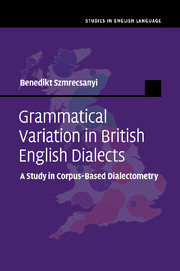Book contents
- Frontmatter
- Contents
- List of figures
- List of maps
- List of tables
- Preface and acknowledgments
- 1 Introduction
- 2 Data and methods
- 3 The feature catalogue
- 4 Surveying the forest: on aggregate morphosyntactic distances and similarities
- 5 Is morphosyntactic variability gradient? Exploring dialect continua
- 6 Classification: the dialect area scenario
- 7 Back to the features
- 8 Summary and discussion
- 9 Outlook and concluding remarks
- Appendices
- References
- Index
6 - Classification: the dialect area scenario
Published online by Cambridge University Press: 05 December 2012
- Frontmatter
- Contents
- List of figures
- List of maps
- List of tables
- Preface and acknowledgments
- 1 Introduction
- 2 Data and methods
- 3 The feature catalogue
- 4 Surveying the forest: on aggregate morphosyntactic distances and similarities
- 5 Is morphosyntactic variability gradient? Exploring dialect continua
- 6 Classification: the dialect area scenario
- 7 Back to the features
- 8 Summary and discussion
- 9 Outlook and concluding remarks
- Appendices
- References
- Index
Summary
The assumption we examined in the previous chapter was that linguistic distance between dialects is proportional to geographic distance between dialect sites. We concluded that this assumption is not perfectly borne out by the data. There is, however, an alternative view, according to which dialect landscapes may be geographically organized along the lines of geographically coherent, linguistically homogeneous, and clearly demarcated “areas within which similar varieties are spoken” (Heeringa and Nerbonne 2001, 375). In Section 6.1, we present a literature review of the history of thought on dialect areas. Section 6.2 proceeds deductively and explores the explanatory power of previous dialect partitions for the present study's dataset. Section 6.3 takes an inductive approach and marshals cluster analytical statistical analysis techniques to derive dialect groupings from the dataset. Section 6.4 summarizes this chapter's major findings.
On the notion of dialect areas
Attempts at regionalization, classification, and the quest for dialect areas all have a long and strongly entrenched tradition in dialectology. Indeed, for a long time the dialect area scenario was a great deal more popular among dialectologists than the more fuzzy – and arguably more modern – continuum view, which we discussed in the previous chapter. How come? Harnisch (2009, 275) notes that “traditional dialectology had an elementary interest in dialectal dissimilarity in so far as it attempted to explore the boundaries (isoglosses) of ‘old’ language spaces along which the variants of certain linguistic features or bundles of features differed.” In pursuing this research agenda, traditional dialectology overlapped with folk beliefs that every language or dialect has, or ought to have, its sovereign territory (Auer 2004, 149–150).
- Type
- Chapter
- Information
- Grammatical Variation in British English DialectsA Study in Corpus-Based Dialectometry, pp. 111 - 127Publisher: Cambridge University PressPrint publication year: 2012

